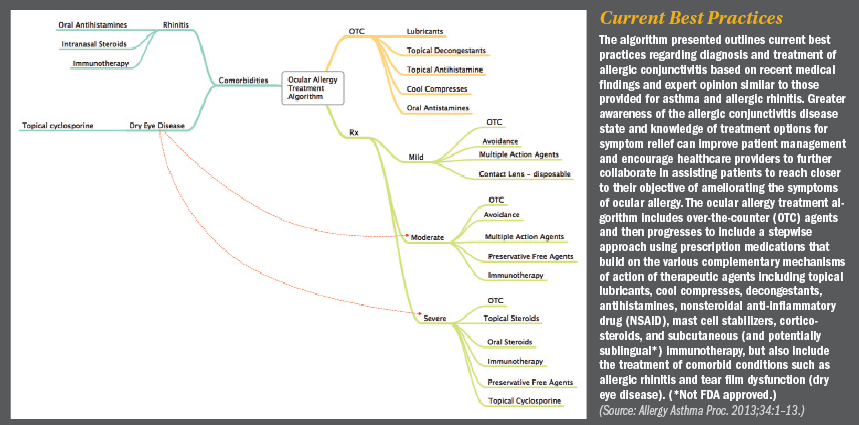Article
Algorithm addresses allergic conjunctivitis
A new algorithm for the management of allergic conjunctivitis encourages collaboration and consensus among colleagues with different expertise as well as greater emphasis on ocular signs and symptoms by physicians who are not eye-care specialists.
Take-home:
A new algorithm for the management of allergic conjunctivitis encourages collaboration and consensus among colleagues with different expertise as well as greater emphasis on ocular signs and symptoms by physicians who are not eye-care specialists.
By Nancy Groves; Reviewed by Leonard Bielory, MD

New Brunswick, NJ-An algorithm for the management of allergic conjunctivitis aims to increase consensus among a variety of specialists who may be dealing with ocular allergy.
The algorithm is a stepwise approach that also addresses comorbidities such as dry eye and the possible impact on the ocular surface of medications customarily used to treat allergies.
In addition, it includes immunotherapy as an alternative treatment approach in patients whose symptoms are more severe.
“It’s basically about the ability to collaborate and communicate in improving the care of the patient,” said Leonard Bielory, MD, an allergist-immunologist in the Department of Medicine, Rutgers University, Robert Wood Johnson University Hospital, New Brunswick, NJ, and longtime advocate of a more holistic approach to managing allergic conjunctivitis.
Dr. Bielory et al. reported their recommendations in Allergy and Asthma Proceedings (2013;34:1-13).
Dr. Bielory, whose co-authors included several optometrists, explained that subspecialists are trained to concentrate on one organ. While specialists in areas other than eye care may regularly treat patients with ocular allergies, they don’t necessarily place sufficient emphasis on ocular signs and symptoms.
“The ocular condition is probably equivalent at times, if not more, than the nasal congestion that is the reason most patients are referred to an allergist,” he said.
The allergist will primarily assess the nasal, skin, and respiratory aspects of the disease, while the eye-care specialist will center on the eye, with less focus on the other aspects of allergic conjunctivitis.
But even when the ocular symptoms seem predominant, chances are extremely high that the patient also has nasal allergy, and vice versa, Dr. Bielory said, adding that the outcomes would probably be better if allergists retained their broad approach of evaluating the nasal, respiratory, dermal, gastrointestinal, and ocular symptoms but had heightened awareness of the ocular aspects and more appreciation of the role that ophthalmologists or optometrists could play in co-managing patients.
As chairman of a joint task force of the American Academy of Allergy Asthma and Immunology and the American College of Allergy, Asthma & Immunology focusing on ocular allergy practice parameters, Dr. Bielory often lectures on this topic and is regularly approached by colleagues who want to learn more about managing ocular allergy and dry eye.
Collaboration works both ways
“There is increasing appreciation by ophthalmologists who normally use a variety of medications in the treatment of patients who come in complaining of ocular allergy and after a time realize that there is no response and that they need further assessment as to what is either the allergen bothering them or that this is not an allergic response, that perhaps skin testing and a further assessment would reveal that they’re not dealing with an allergic response. That would be important before adding more and more medications that don’t work,” Dr. Bielory said.
The algorithm that Dr. Bielory et al. developed begins with patient history and examination evaluating for severity of itching and whether the itch is intermittent or persistent. Other ocular symptoms, such as foreign body sensation, tearing, burning, and redness, should also be addressed.
Symptom duration and prior treatments are also noted. Each symptom is classified by severity level (mild, mild to severe, or moderate to severe), with appropriate first-line and alternative treatment recommendations and follow-up guidelines.
- Step 1 of treatment of patients with mild, intermittent itching may involve nonpharmaceutical measures, over-the-counter medication, or an ocular antihistamine/mast cell stabilizer.
- Step 2 patients with mild or intermediate to severe itching but no severe redness or concurrent ocular conditions should be treated with a topical ocular antihistamine/mast cell stabilizer, or in some cases, corticosteroids.
- Step 3 patients with moderate to severe symptoms and redness should be treated with a topical ocular antihistamine/mast cell stabilizer, a topical ocular corticosteroid, or both.
The other concept within the algorithm is the addition of immunotherapy for those who have chronic allergic disorders in addition to nasal and respiratory symptoms. Immunotherapy has been shown to assist in improving the overall quality of life while reducing the frequency and amount of other medications for the treatment of allergies and asthma.
Leonard Bielory, MD
Dr. Bielory is a consultant for Allergan and Bausch + Lomb, is on the committees of Merck and GlaxoSmithKline, and has received financial support from Sanofi and grants from Allergan.
Subscribe to Ophthalmology Times to receive the latest clinical news and updates for ophthalmologists.
Newsletter
Don’t miss out—get Ophthalmology Times updates on the latest clinical advancements and expert interviews, straight to your inbox.




